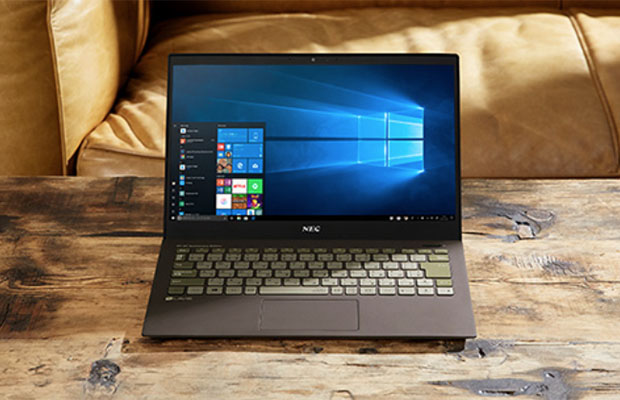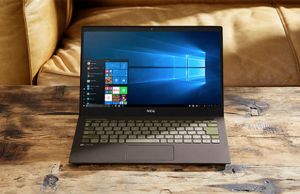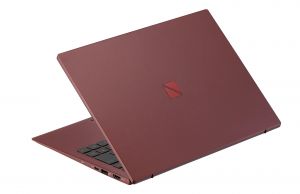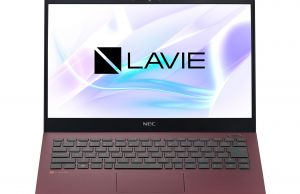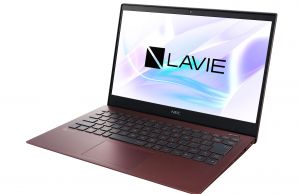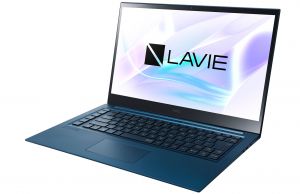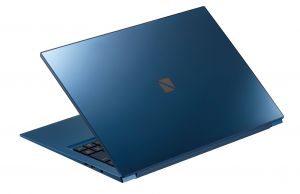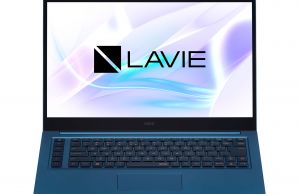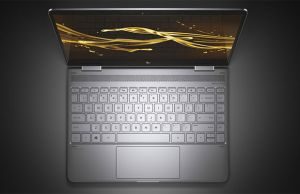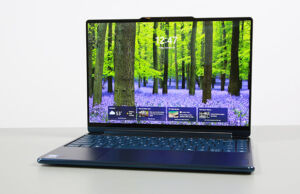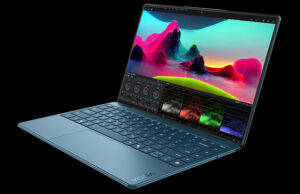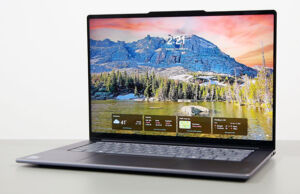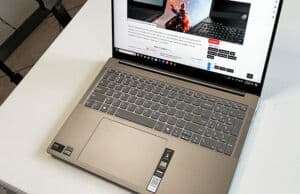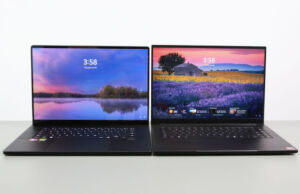Table of Contents
For the last year, NEC and Lenovo have been working together on a handful of interesting ultraportable notebooks mostly available in Japan, as part of the LAVIE lineup.
As of 2020, several of the latest LAVIE notebooks will also be available in the US, and among them, there’s the peculiar NEC Lavie Vega 15-inch notebook, and the highly portable 13-inch NEC Lavie Pro Mobile.
The Pro Mobile is an ultralight and highly portable 13-inch laptop, but the Vega is a more interesting device due to its unique mix of features: a 15-inch OLED display, a full-power Intel Core i7 processor, an 80Wh battery, Thunderbolt 3 and no dedicated GPU.
We’ll talk about both below and point to what puts them on the map and their potential drawbacks in today’s market.
| NEC Lavie Pro Mobile | NEC Lavie Vega | |
| Screen | 13.3 inch, 16:9, 1920 x 1200 px resolution, IPS, matte, 300 nits | 15.6 inch, 16:9, 3840 x 2160 px resolution, OLED, 400 nits |
| Processor | up to Intel Whiskey Lake i7-8565U (4 cores, 8 threads) | up to Intel Coffee Lake i7-9750H (6 cores, 12 threads) |
| Video | Intel UHD 620 Graphics (integrated) | Intel UHD 630 Graphics (integrated) |
| Memory | up to 8GB LPDDR3-2133 (soldered, dual-channel) | up to 16GB DDR4-2666 (soldered, dual-channel) |
| Storage | 1x M.2 80 mm PCIe x4 | 1x M.2 80 mm PCIe x4 + Intel Optane memory 32GB |
| Connectivity | WiFi 5 AC, Bluetooth 5.0 | WiFi 6 AX, Bluetooth 5.0 |
| Ports | 1x USB-A 3.1 gen2, 2x USB-C 3.1, HDMI 1.4b, microSD, headphone jack | 2x USB-C Thunderbolt 3, 2x USB-C 3.1 Gen 2, 1 MicroSD, headphone jack |
| Battery | 49 Wh, power adapter (barrel) | 80 Wh, power adapter (USB Type-C) |
| Size | 308 mm or 12.12″(W) x 216 mm or 8.5″(D) x 15.5 mm or .62″(H) | 360 mm or 14.17″(W) x 244 mm or 9.61″(D) x 18.3 mm or .73″(H) |
| Weight | ~.840 kg / 1.85 lbs (+ power supply) | ~1.85 kg / 4.1 lbs (+ power supply) |
| Extras | Yamaha tuned 2x 2W speakers, 2x mics, fingerprint sensor in Power button | Gorilla Glass 6 top, Yamaha tuned 2x 2W speakers, 4x mic array |
NEC Lavie Pro Mobile
This is all about the portable form-factor and the lightweight.
It weighs just shy of .84 grams (1.85 lbs), making it one of the lightest notebooks on the market. Fujitsu and Samsung offer slightly lighter 13-inch options, but they sacrifice on battery life, which this one does not. In fact, the Lavie Pro gets a 49 Wh battery, similar in size to what you can find on many competitive ultrabooks of the moment, such as the Dell XPS 13, Asus ZenBook S or the Acer Swift 5. That’s going to offer 4-10 hours of battery life with actual use, or up to 15h in you take NEC’s marketing claims for granted.
The Lavie Pro Mobile doesn’t compromise on the IO, build quality and typing experience either. It gets a full-size backlit keyboard, full-size connectivity, a finger-sensor integrated within the dedicated power button, and an outer shell made from a mix of magnesium/lithium and aluminum alloys. It’s also quite a looker, with simple design lines and a Bordeaux Red color scheme. This might not appeal to everyone, but it is an interesting option that we’ve only previously seen on the ZenBook S, with its Burgundy Red variant.
I do feel that this 13-inch model lacks in the hardware department, though. It’s still built on last year’s Whiskey Lake hardware and the specs only mention up to 8 GB of RAM. That’s fine for everyday use, but might not suffice for more demanding loads.
This should come to no surprise, as the Lavie Pro Mobile has been available on the Japanese market since May 2019. It was just recently brought to the US, but I would have expected a hardware update as well.
The screen is another aspect where this feels a bit outdated. NEC offers it with a 13″ FHD matte 300-nits panel, while many premium ultrabooks get brighter panels, touchscreen, and even higher-res options. I’m fine with FHD on a 13″ panel, but based on our experience with similar 300-nits screens, this laptop will most likely struggle outdoors or in bright environments.
All these might make the Lavie Pro Mobile a hard-sell in its class, especially since it competes in the premium niche, with a starting price of $1599 (availability scheduled for March 2020). You’d really have to care about that lightweight build to justify paying this sort of money for what’s basically an early-2019 ultrabook with fancy clothes.
NEC Lavie Vega
The Lavie Vega, on the other hand, is a completely different product with little to no direct competition, and that’s because it offers an unusual mix of features: premium construction and sub-4-lbs weight, an OLED 4K display, a six-core full-power Core i7 processor, a big battery and no dedicated graphics.
On a first look, this looks like a competitor for the Dell XPS 15 or the Lenovo ThinkPad X1 Extreme, but then you find out that it doesn’t get a dGPU. That leaves it a full-size 15-inch ultrabook, but it is fairly heavy compared to the other 15-inch options out there, like the Microsoft Surface Laptop 5 or the Asus ZenBook 15 or the LG Gram 15, and also very expensive, at $2100 and up. On top of these, the full-power i7 processor is not as efficient as the Core U i7s available in some other 15-inch laptops, and the lack of any sort of dGPU limits its versatility in demanding chores that would benefit from that processor, not to mention games.
So who is this for, then?
For starters, as a potential customer, you’d need to accept and pay the premium for the OLED screen. OLED looks spectacular for movies and browsing and everyday use, but is not necessarily what I’d get on a laptop these days, for a couple of different reasons: burn-in, graininess, black crush and grey-bending, among others. I’ve explained these aspects in our reviews of the OLED based XPS 15 and ZenBook Pro Duo.
Then you’d also have to pay a premium for the premium build quality and exquisite looks. Metal is used for the entire outer-case, with a Gorilla Glass 6 covered top, something we’ve previously seen on the ZenBook Pros a few years ago. The glass top looks nice on the shelf, but is an awful magnet for smudges in real-life, so not something I appreciated at that time. Perhaps NEC did better here, somehow?
Finally, you’d have to appreciate a notebook that would just fly with everyday use and CPU demanding loads (at least on theory, something we’d have to look over in a detailed review), while lasting for 4-6 hours on a charge. Yes, it gets a fairly large 80 Wh battery, but don’t forget that it needs to accommodate the power-hungry 45W Intel platform and OLED screen, so it won’t last as long as other 15-inch ultrabooks with maybe smaller batteries.
In the end, I believe this would primarily make for a good choice for someone who needs a competent 15-inch work-laptop with fast processing capabilities, good keyboard, and long battery life, but also the ability to do well when hooked up to an external dGPU like the Razer Core or the Aorus Gaming Box. This is where the full-power processor without supporting graphics would really make sense, but even if that’s you, the OLED screen and steep entry-price would still be potential deal-breakers.
I’m curious about your thoughts on these NEC Lavie Pro Mobile and Vega notebooks. Are they competitive enough to make sense on the highly-saturated US market?

